This article may contain affiliate links. Please see our affiliate disclaimer in the footer menu for more information. Thank you for your support!
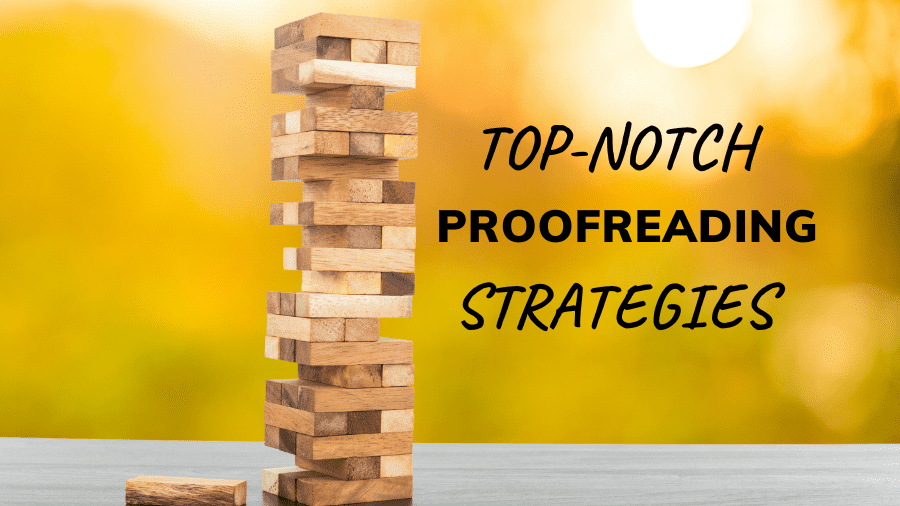
Are you looking for effective proofreading strategies to improve your writing and give it a polished and professional appearance?
Overlooked mistakes can convey carelessness and detract from your message.
Therefore, I’ve compiled this list of tactics to help you put that final polish on your prose. I hope these techniques help you eradicate errors, transform typos, and fix formatting fumbles!
Effective Proofreading Strategies to Improve Your Writing
Let’s tune in to the tried-and-true tactics that will help you elevate your writing no matter what type of proofreading you’re performing.
1) Read the text out loud to yourself or someone else.
This allows your ears to participate in the proofreading action. Sometimes our ears pick up on what our eyes miss.
When I read a document to myself, I find that speaking in a robotic voice (pronouncing each word clearly) helps me slow down and keeps me entertained.
If I read to someone else, I use my normal voice unless my audience happens to be a robot aficionado. 😉
Reading my blog posts to my grandmother allows me to catch errors I missed during proofreading. It especially helps me identify when I’ve omitted tiny words like it, if, or as.
2) Let your computer read the document aloud to you.
Are your eyes getting tired? Give them a break while listening to the computer read your writing using the text-to-speech function.
If something doesn’t sound right, you may have found a blunder that needs correcting.
If you’re not sure how to enable this function in Word, you can read this brief article by Microsoft support.
If you’re using another word processor, I recommend searching Google or YouTube for information about setting up text-to-speech capability.
3) Sleep on it to ensure effective proofreading.

Print the document, put it under your pillow, and drift into dreamland. You’ll have nightmares about the text’s errors. When you scrutinize your sentences the following day, those fumbles will be familiar, and it’ll be a breeze.
Okay, maybe I haven’t tried that method yet, but I don’t have high hopes. 😉
A better option is to leave it alone until later—ideally, overnight.
The longer you can leave your writing, the better.
It’s difficult to proofread our own writing because we become too familiar with it. When we try to find mistakes, our brain sees what we meant to write instead of what actually ended up on paper.
4) Proofread a paper copy (aka a hard copy).
Many people swear by this proofreading strategy. I do too. I began freelance proofreading on paper and then moved to on-screen proofing when I gained more confidence.
Not having to contend with the glare from a computer screen is a welcome change. It’s also less tiring for your eyes.
Of course, you’ll need a red pen here so you can easily see your proofreading marks.
5) Go slowly!

“Life is a journey, not a destination.” Ralph Waldo Emerson could have said the same about proofreading.
Going slowly is one of the most obvious and effective proofing techniques, but many people still proofread at a speed-reading pace because the process bores them.
It helps to print out your document and put a ruler or blank paper under the line of text you’re reading.
This ensures you go slowly and only focus on one line at a time.
And let’s enjoy the time we spend on error patrol!
If you ever feel like scanning your sentences for slipups is a waste of time, I wrote an article about why proofreading is essential. After reading it, you’ll feel better about spending time eradicating errors in your writing.
Be mindful of the benefits as you kick those mistakes to the curb! You’re doing great! 😊
6) Get a bird’s-eye view of the writing by zooming out.
Even if you’re a professional proofreader, and especially if you aren’t, it can be easy to forget to clean up formatting fumbles. If you zoom out a bit, you can view the entire page—making it easier to spot those formatting faux pas.
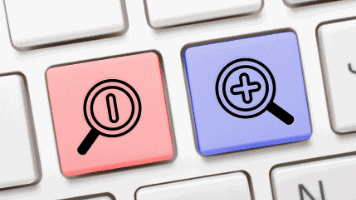
If you zoom out even further, you’ll be able to see multiple pages side by side. Sometimes we remember to address formatting issues on individual pages but forget to compare pages to notice any formatting inconsistencies.
Printing out a document is another way to address these inconsistencies since it enables you to compare the writing from one page to the next.
If you’d like to know more about the features in Word that can assist you with zooming out on pages in various ways, please check out the YouTube video below. (The video does not contain sound.)
7) Proofread when you’re most alert.
This will be in the morning for many, depending on the individual. Most people have a time during the day (or night) when they feel their concentration is at its peak.
What if you have to proofread when your concentration is fading?
Get the blood flowing in your body and brain!
Some jumping jacks and squats work well when dealing with a deadline and needing to regain focus quickly. Doing deep breathing or walking outside can also help pick you up.
I once knew someone who even resorted to laying down with their head hanging over the side of the bed to increase blood flow to their brain, hoping that would help. Oh wait—that was me. 😉
8) Read your paper backward, sentence by sentence.
If a document isn’t too long, reading it backward can be an effective way to catch a few flubs you may otherwise miss. Although this process takes time, it’s well worth the effort.
Start with the last sentence of the text, and read it sentence by sentence—from left to right as usual—until you reach the first sentence in the document.
This technique will help you slow down. It will interrupt the flow of writing so your brain doesn’t anticipate what’s next.
9) Cut out distractions.

Finding a quiet environment can help you concentrate better and, in turn, allow you to detect additional errors in your writing.
If you can’t work in a peaceful environment, earplugs are an option.
If earplugs don’t cut it for you (they don’t work for me), you can invest in noise-canceling headphones.
10) Proofread your document more than once.
You’ll be amazed by how many mistakes you see when you read your writing for the second or third time. How did those errors slip by you the first time?
Discovering additional blunders each time you read your paper will teach you to go slowly when reading your writing initially. With practice, it’ll become easier to spot slipups.
11) Change the text in some way.
Change some element of the paper (e.g., font size/color/style, spacing between lines, overall layout).
Altering the document’s appearance makes mistakes more visible since you’ll perceive reading the modified text as a new experience.
Proofing a double-spaced document gives gaffes room to stand out.
Also, dividing the text into two columns can be effective since your eyes don’t have to travel across the entire length of a page while reading each line.
12) Give yourself enough time to proofread.
Most people underestimate the time needed to proofread their prose. Giving yourself ample time will ensure your writing is as error-free as possible.
Proofreading will also be a much more enjoyable experience if you’re not racing against the clock to complete it.
13) Take frequent breaks to rest your eyes and brain.
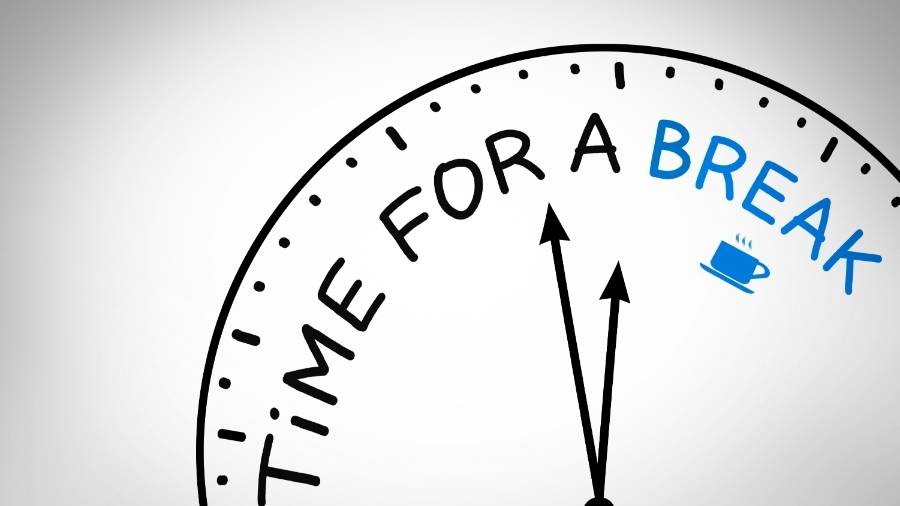
Proofreading can be tedious since it requires intense concentration. Taking periodic breaks enables you to maintain focus.
Using the Pomodoro technique is one way to keep yourself accountable for taking breaks.
With this method, you work for 25 minutes and then take a 5-minute break. After your fourth 25-minute work session, you take an extended break (15–30 minutes). Then you repeat the cycle.
The Pomodoro technique can help keep your concentration up to par. It’s one of my favorite proofreading hacks by far!
14) Don’t depend on spellcheckers and grammar checkers.
Spellcheckers aren’t foolproof.
They have a limited dictionary, so they may think that certain industry-specific terms are misspelled, even when they’re not.
They also don’t notice when you use the word peak when you need the word peek or pique.
Spelling mistakes may seem inconsequential, but they can have surprisingly negative consequences. I published an article called “11 Reasons Why Spelling Is Important in Writing” if this topic peaks piques your curiosity.
Grammar checkers aren’t foolproof either.
Since they can’t determine context, they sometimes make erroneous suggestions.
If you accepted every change a grammar checker recommended, your paper would inevitably contain errors.
15) But do use spellcheckers and grammar checkers as a backup.
I run spell-check right off the bat to eliminate any obvious blunders that might distract me from finding the not-so-obvious ones.
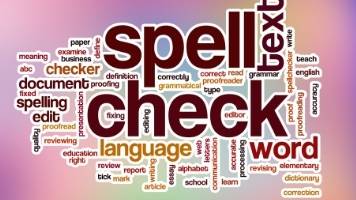
After proofreading a document, I use Grammarly Premium to detect any mistakes I may have overlooked. Although I reject some of its suggestions, I’ve found it to be an excellent backup.
A free version is available if you don’t want to pay for the premium one.
16) Invest in PerfectIt to quickly find errors with consistency.
If you regularly write lengthy documents and really need your writing to shine, consider investing in PerfectIt.
In addition to checking for typos and spelling slipups, PerfectIt checks the consistency of capitalization, hyphenation, and the treatment of numbers.
You can set the software to proofread in US, UK, Canadian, or Australian English.
PerfectIt saves me a lot of time because checking a piece of writing for consistency isn’t a quick task, especially with long texts.
17) Know what to look for and what to ignore.
If you’re unsure what to check for, you may want to read my post about what proofreaders look for.
This article gives you an overview of the main errors to look for and provides examples of some of those blunders. I hope you find it helpful! 😊
Being aware of what to ignore is also essential.
Before becoming a trained proofreader, I had been holding on to some grammar rules that were no longer applicable.
Wasn’t it always wrong to end a sentence with a preposition?
I thought this was a big no-no. I was mistaken.
I also learned that beginning a sentence with a conjunction (and, but, so, etc.) is perfectly acceptable.
Who knew? I certainly didn’t.
Just keep in mind that some of the language rules you’ve learned so far may not be applicable now.
18) Make a checklist of the errors you need to look for.

A checklist will remind you of everything you need to look for. It would be ideal if you could make the list yourself. Jotting down the items you need to check and reviewing the list before you start proofreading can help you approach the task with increased focus.
If you need help remembering some of the essential elements to look for, Om Proofreading provides this post that can serve as a checklist.
19) Check for only one or two kinds of mistakes at a time.
For example, check for grammar and spelling on one pass, punctuation and capitalization on the next, then formatting on the last.
You may need to include a separate pass for any types of errors you know you’re prone to overlook.
As you get additional experience, you’ll learn to look for everything simultaneously.
20) Circle every punctuation mark.
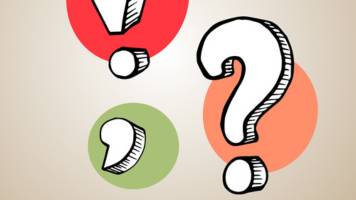
If you struggle to find punctuation-related mistakes, print out your paper and circle every punctuation mark in red.
Each time you circle one, you can decide if it’s correct.
Also, remember there could be punctuation that is missing.
21) Pay special attention to homophones.
Homophones are words that have the same pronunciation but different meanings (and usually different spellings).
For example, if I write soar thumb instead of sore thumb, this is a homophonic error. This kind of slipup can be challenging to detect since it sounds fine.
Om Proofreading talks about tricky homophones and provides a quiz at the end of the article if you’d like to brush up on some of these confusing words!
Or you can jump right into evaluating your knowledge of homophones by checking out the first quiz in my post that’s full of proofreading tests and quizzes.
22) Don’t forget about minor formatting fumbles.
We frequently forget about the finer formatting faux pas since they often deal with space, such as improper spacing between paragraphs.
We pay attention to the words on the page, but we also need to consider the layout of the text, from one line to the next.
If you’ve written an academic document, make sure you’ve followed any applicable formatting specifications for your paper.
The Purdue Owl Online Writing Lab is one of the best resources for learning how to format academic papers at the graduate and undergraduate levels. I used it extensively in college to ensure I formatted citations correctly.
The writing lab also provides excellent strategies for proofreading and editing. I highly recommend it!
23) Don’t forget headings and subheadings either.
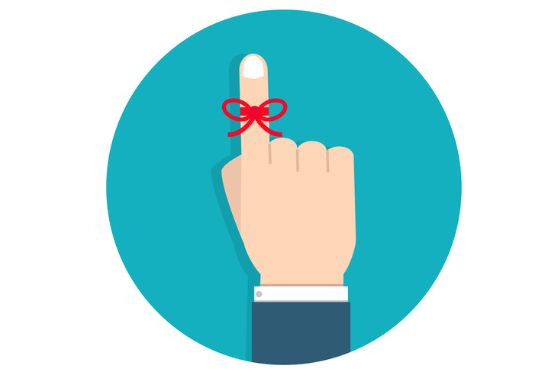
These can be surprisingly easy to forget since we’re always so focused on the words in the body of a text.
However, since we typically use a larger font for headings, any errors will be evident to our readers.
They’ll stick out like a soar sore thumb!
24) Take advantage of Find and Replace.
Louise Harnby, a well-respected fiction editor and proofreader, created a free e-book called The Author’s Proofreading Companion.
This is a fantastic resource about using Find and Replace to quickly correct pesky problems in a text.
My favorite trick from her list involves finding and fixing extra spaces.
To do this, type two spaces into the Find box and one into the Replace box. You can then change all the instances of extra spaces at once or look at each case to determine whether you’d like to change it.
The shortcut in Word and Google Docs for the Find and Replace function is Ctrl + H.
Furthermore, if you’re aware of the mistakes you tend to make, use the Find feature to check for these.

The shortcut for the Find feature in Word is Ctrl + F. In Google Docs, the Find function is within Find and Replace.
For example, if you tend to write your when you mean you’re and vice versa, type your into the Find box and check that you’ve used it correctly on each occasion. Then do the same with the word you’re.
25) Don’t try to memorize all the rules.
You may be overwhelmed by all the rules you need to know to proofread a text effectively.
We have so many specific rules just for the use of commas alone! How can you possibly memorize all of them?
The good news is that you don’t have to. All you need to know is where to look to find the answers.
Become a good researcher!
And if you’re unsure about something, look it up!
It’s tempting to take an educated guess when you’re reasonably sure you know the proper spelling of a specific word or how to punctuate a particular phrase.
However, to be safe, it’s better to consult the appropriate resource whenever you have a doubt.
26) Have a family member or friend read your writing.
Having a second pair of eyes on your writing is always a good idea.
Since your brain is so familiar with what you’ve written, your eyes tend to see what you think you wrote instead of what you actually wrote.
Fresh eyes will catch more mistakes.
27) Hire a professional proofreader.
Having a second pair of well-trained eyes on your writing is even more beneficial.
Proofreaders are taught to find fumbles that most people would miss due to not realizing they were errors in the first place.
They’ve also honed their eagle eyes with lots of practice, enabling them to detect and correct many more mistakes than untrained eyes.
Finally, most proofreaders are innately perfectionistic and detail oriented.
I authored an article about how to hire a proofreader if this is something you’re considering.
Frequently Asked Questions
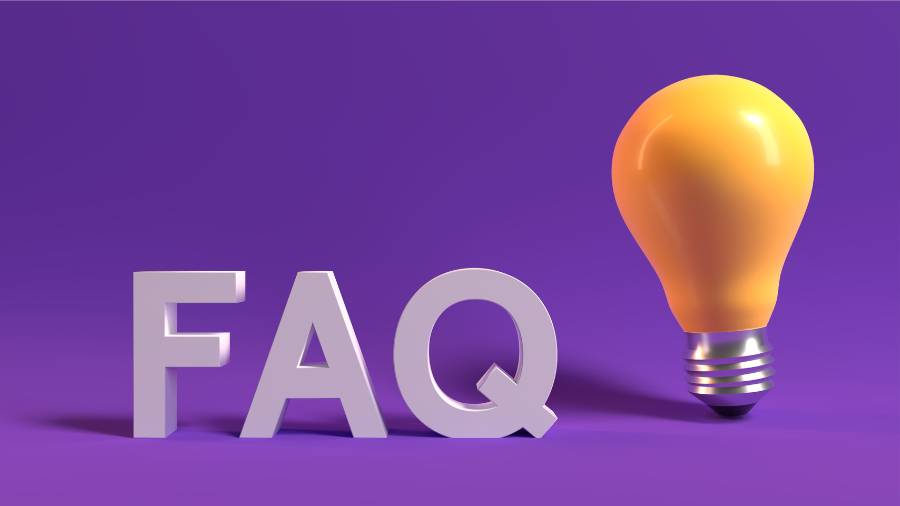
How can proofreading improve my writing?
Proofreading can improve your writing by allowing you to say what you mean to say clearly and effectively. It helps readers understand your message without getting distracted by mistakes. It also enhances your credibility and shows you care about your work. Finally, polished writing looks refined and professional.
What are the types of proofreading?
Proofreading can be divided into four types: academic, print media, business, and translation.
Academic proofreading involves working with papers produced by university students, researchers, and professors in academia.
Print media proofreading entails checking the writing of publishers and self-publishing authors.
Business proofreading deals with checking the content produced by business owners and entrepreneurs.
Translation proofreading means finding flubs in texts translated from one language to another.
What are the basics of proofreading?
Proofreading is the last stage in the editorial process—it comes before editing. Proofreading involves scrutinizing a document for errors and inconsistencies in five primary areas: grammar, capitalization, punctuation, spelling, and formatting. It also entails fixing mistakes with word usage and repeated or omitted words.
What makes a good proofreader?
A good proofreader is meticulous, conscientious, and independent. They have an excellent command of the English language, a firm understanding of style guides, the ability to use certain software, broad general knowledge, intense focus, and top-notch time management skills.
What are the best proofreading strategies to improve your writing?
The best proofreading strategies to improve your writing are the ones that work for you. However, one of the most effective strategies for proofreading your own work is to leave it alone as long as possible. For proofing a document you didn’t write, reading it aloud or having your computer read it is a super strategy. And remember that we need to proofread slowly!
What are style guides in proofreading?

Professional proofreaders use style guides to inform the corrections they make. We use different style guides for different genres of writing. For example, The Chicago Manual of Style is used in book publishing.
Other well-known style guides include the following:
- The Associated Press Stylebook (for journalism)
- the Publication Manual of the American Psychological Association (for social sciences)
- the MLA Handbook (for the humanities)
How can I become a better proofreader?
The only way to become a better proofreader is to keep practicing and learn more about the kinds of errors you need to look for.
If you want a fabulously fun way to improve your skills, I recommend using an app called Elevate. A free version is available! I use it often to help me hone my skills, and I love it!
I hope these proofreading strategies will assist you in putting the final polish on whatever text you have on your screen or in your hands! 😊
Best wishes to you!
“What is done in love is done well.”
– Vincent Van Gogh
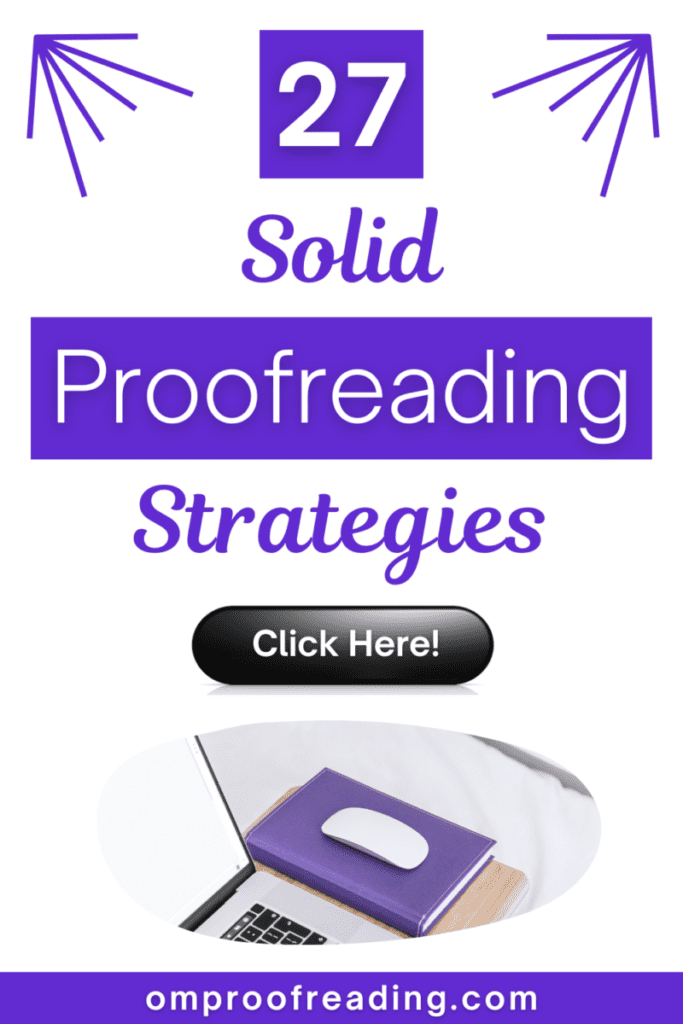
Recent Posts
Punctuation is important because it enables us to communicate our message clearly and effectively. Without punctuation, we wouldn’t understand how units of a sentence relate to one another or how...
Although you're probably somewhat familiar with adverbs, you may be unaware of sentence adverbs. As a trained proofreader who has studied the parts of speech, I can help you understand this unique...
